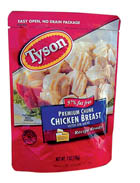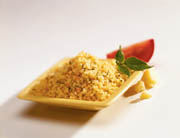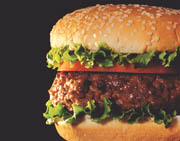
Meat manufacturers can take a hint from innovations in meat analog technology. If a product containing no meat can pass as meat to many consumers, then the quality of extended meat products also can be much better. Formulating low-fat meat products requires an understanding of the mouthfeel, texture and flavor of the original meat product as well as knowledge of how different ingredients can best help to imitate those qualities.

Jack Sprat Could Eat No Fat
Meat extension has been around since the early 1950s, due mainly to economic incentives. Adding water and economical plant proteins to certain formulas increases meat yield at little to no cost to the manufacturer. Since the beneficial nutritional properties of such products often remain little changed, the option is popular for products in school lunch programs, the military and many other foodservice venues. More recently, a demand for fat-reduced meat products has increased among consumers in developed countries. Factors such as weight control concerns and the release of studies showing correlations between saturated fat and risk of cardiovascular disease, certain cancers and obesity (which can lead to Type 2 diabetes) have spurred demand. Even so, perhaps low-fat meat-product launches are stunted due, in part, to their association with negative sensory qualities.The quality of reduced-fat meat products with starch, gums or proteins and water systems has improved over the years. “We realized regulations that classified [water-added meat] as inferior is counterproductive,” says Abe Bakal, president of ABIC International Consultants Inc. (Fairfield, N.J.). For one, the addition of proteins such as soy and whey can increase the biological value of meat.
“Consumers are becoming more knowledgeable about the health benefits of soy,” says Mian Riaz, head of the extrusion technology program at Texas A&M's Food Protein Research and Development Center (College Station, Texas). Soy proteins have proven beneficial to heart health, while whey proteins provide the highest source of branched-chain amino acids and leucine, which certain studies have associated with weight loss. Additionally, some ingredients that help reduce fat also can increase a product's fiber content. Nevertheless, with the obesity issue looming over every manufacturer's nutrition label, the most obvious reason to add water to meat is to reduce the fat.
Where's the Beef?
Adding water to lean meat creates a low-fat formulation. Binders “trap” the water and increase the yield. “The challenge lies in maintaining the integrity of the meat product,” claims Gil Bakal, managing director of a leading supplier of rice-based food starches. “If you over-extend the meat, it can be unsightly.” Other problems that arise involve freeze/thaw instability and purge in the refrigerator. Additionally, moisture is lost during the cooking process. Such syneresis and drip loss can result in hard, chewy and dry products.To minimize these occurrences, stabilizers and water-binders are added to retain moisture. Starches of different origins are a notable example. Combinations of these ingredients are injected into or tumbled with the meat as marinades and/or brines.
Cornstarch, with a granule size of 15-25µm, often is used as a basic thickener, but rice starch, wheat gluten, modified potato starch and tapioca also are common. “Some starches won't be stable in the refrigerator or freezer, during cooking or at a low pH,” says Gil Bakal.
Water also can be stabilized with soy and whey proteins. Generally, protein isolates have the capacity to bind more water than protein concentrates. Most protein isolates contain less than 1% fat. Both textured vegetable and dairy proteins have a binding capacity similar to isolates.
Protein sources do not have to be limited to soy. “We use peanuts, remove the oil and then texturize the peanuts,” explains Riaz, who admits peanut proteins tend to be higher in fat. Although soy is most popular in North America, chick peas and green pea protein concentrates are used by Canadians and Europeans in meat extensions because they are more widely available in those countries.
Hydrocolloid gums like alginates, carrageenan, guar and xanthan make regular appearances in formed meat and fish products but generally are used in combinations with starches and proteins.
In North America, inulin frequently is used in meatless, vegetarian dishes, but not in formed or extended meat and fish products. Inulin, which acts as a dietary fiber, works well with hydrocolloids by facilitating hydration and adding mouthfeel. Inulin's functions in vegetarian dishes easily can be transferred to non-vegetarian dishes.
Another consideration manufacturers should be mindful of is how fat assists in heat penetration. Consequently, longer cooking time is required to reach the internal temperature of a meat product when water replaces fat. The addition of water also increases the risk of microbiological activity. Sugar alcohols like glycerin, sorbitol and lactitol can be used to reduce water activity and extend the shelflife of meat extensions, notes Abe Bakal.

Chewing the Fat
Although water retention is the most economical component of fat replacement, the most appropriate water-binder should be chosen based on desired texture and mouthfeel, not water-binding capacity. Consumers will not buy a product if it does not fulfill the sensory standards to which they are accustomed. “Formulation will depend on the texture you are shooting for as well as the [equipment] pump and the amount of water added,” suggests Gil Bakal.For each particular type of product, manufacturers should determine the lowest acceptable fat content before palatability is compromised and work up from there. Oftentimes, such exacting considerations will result in a combination of fat mimetic ingredients.
Regardless of the shape or flavor, one knows the difference between biting into a hotdog or a bratwurst. Also, a chicken patty should have a different bite and texture than a hamburger patty. Texture varies even between individual cuts and grades of meat. As a result, certain fat replacers are suitable in comminuted meat like paté, but not in a ham roast.
For instance, rice starch, which has a granule size of 2-8µm is more suitable for ground and re-structured products (like liverwurst) because rice forms a softer texture. “Its small size enables the rice starch to penetrate and bind water deep within the muscle fiber, instead of forming a film on the surface as most other starches do,” says Gil Bakal.
The mouthfeel of processed meat relates to the particle size of the water-binder, he adds. Rice starch has a creamy mouthfeel because the granules are so small.
Rice starch can help to eliminate “gel pockets” normally associated with other starches of a larger particle size. The appearance of gel cubes may be more of a problem with red meats, but not in white meats and poultry. On the other hand, the appearance of gel can help in mimicking a marbled appearance that is common to some meat products.
“With a hotdog, you can use rice starch for mouthfeel, but you need to add other things like carrageenan or cornstarch to get that firmness back,” recommends Gil Bakal. Hydrocolloids also act as fat mimetics by stabilizing meat marinades, thereby adding back lubricity. In addition to water binding, whey proteins can easily form emulsions that will stabilize other fat-replacing ingredients.
Unfortunately, there also are negative aspects to the small size of rice starch, as the individual particles create aggregates or clumps. This problem easily is resolved by applying high shear to the brine or marinade.
“If you reduce all of the fat, you will have a dry mouthfeel and a rubbery texture,” reports Riaz. Formulated meat extensions have an advantage over veggie meats in that even though the fat is reduced, the presence of the natural fat in a meat will accentuate mouthfeel and flavor. “Manufacturers never really worry about the mouthfeel, they just add water binders and try to match the texture,” reports Gil Bakal.
An Oil Change
The loss of flavor is one of the greatest disadvantages of reducing fat content. “Each fat has its own characteristic flavor,” says Sharon Gerdes, a technical support consultant for DMI (Rosemont, Ill.). Removing the fat eliminates the distinctiveness of the meat flavor, reducing its character to the familiar “cardboard taste” associated with low-fat meats. Flavor molecules may be more volatile when increasing water and decreasing fat content. As a result, more spices and seasonings may need to be added, causing potential conflict with textural formulations.Although whey protein commonly is not applied to meat extensions, many in the whey industry are advocating its increased use. Whey proteins generally function the same as soy proteins in meat products, but the advantage is that whey protein isolates and concentrates are relatively bland ingredients. “There is absolutely no aftertaste whatsoever,” opines Marie Walsh, associate professor in the department of nutrition and food science at Utah State University (Logan, Utah). Whey has been known to absorb fat and bind flavor chemicals, which will help in the distribution of flavor. Where taste is concerned, vegetarians and soy-eaters are accustomed to the taste of soy in veggie-burgers but, continues Walsh, “whey might be a better choice for a general consumer market.”
Reduced-fat meats often cost more than full-fat meat products. Finding economical ingredients is the hurdle that meat manufacturers must jump. Some fat-replacers cost more than others and hydrocolloids often are expensive.
“A challenge with textured whey protein is trying to convince manufacturers that whey works just as well as the other ingredients,” proclaims Walsh. “A lot of companies hesitate to try textured whey protein because their formulations are all set with soy and they think it will be a big leap.” Such parameters inhibit many manufacturers from crossing over from soy. Whey, however, has drawn significant attention of late. Recently, a textured whey protein ingredient was licensed to extend beef and pork.
Know Fat Off the Back
As a result of low-carb diets, meat-eating is back in fashion. However, as the low-carb diet trend wanes and the FDA revitalizes its stance on calorie counting, interest in lean meat may again pick up. Low-carb influences have caused some manufacturers to replace the starch in breading and coating with proteins, fibers and non-digestible gums. “Replacing carbs with fiber is more marketable to people on a high-protein diet,” asserts Walsh, who currently works with a manufacturer to substitute hydrolyzed oat fiber for carbohydrates in processed meats.Adding water and fat-replacing ingredients to extended meat products can be complicated as government regulations for standards of identity concerning water weight and additives vary between applications. For example, in the U.S., water added to “luncheon meat” during manufacture cannot exceed 3% by weight of the total ingredients, but there are no international standards for processed meats.
Nutrient content claims relating to fat reduction are identified in the Code of Federal Regulations for meat products in 9 CFR Part 317 and for poultry products in 9 CFR Part 381. However, according to a USDA spokesperson, the Food Safety and Inspection Service issued a direct final rule in 2003 that somewhat diminished the effect of certain policy memos related to the addition of binders to reduce fat. Meat manufacturers can circumvent discrepancies in regulatory actions by consulting with a formulation expert familiar with USDA policies.
Sidebar
Showcase: Dairy-, Soy- and Gelatine-based Proteins; and Fat-replacing IngredientsWhy use proteins derived from soy and wheat for meat applications? Vegetable proteins improve taste, texture and nutrition. ADM supplies NutriSoy soy proteins that further increase tenderness and juiciness when infused into marinated chicken breasts, pot roast, roast beef and ham. Whether enhancing the appeal of top-quality deli meats or looking for the latest in soy-based meat replacements, the company offers a broad range of ingredient options, expertise and support for soy-based foods. ADM, Chris Banocy, 217-424-5200, info@admworld.com
A novel egg replacement system is a unique blend of ingredients designed to replace whole eggs, egg yolks and egg whites in a wide range of baked goods. ELEGGANCE™, from National Starch, exhibits superior textural and organoleptic properties typical of high-quality baked goods containing eggs. The product is easy to use, lowers production costs, eliminates egg-related processing safety issues and lowers cholesterol content. Recommended for binding, structuring and heat-induced gelling applications, ELEGGANCE provides superior emulsification, moisture retention and batter viscosifying properties. National Starch, 800-797-4992, nscinquiry@salessupport.com
When reducing calories and fat, maintaining the texture and taste of foods can be difficult. Paselli SA2 and Paselli WFR are potato-based gelling maltodextrins that impart fat-like mouthfeel and stabilization in low-fat foods. A gel made from these bland, low-calorie fat substitutes can replace a large portion of fat and keep texture and juiciness in processed meats and cheeses, spreads, sour cream and icings. Paselli WFR provides the opacity and fat mimetic character found in full-fat products, especially mayonnaise and dressings. Paselli SA2 offers the same full-fat characteristics with more clarity. Both are kosher and GMO-free. AVEBE America Inc., Jane Petrolino, 609-951-2044, petrolinoj@avebe.com
The small granule size and soft gels of rice starch create a creamy texture that strongly resembles the taste and mouthfeel of milk fat in ice cream. A sensory group concluded that reduced-fat ice cream made with A&B Ingredients' Remyline DR and 6% milk fat was comparable in flavor, taste, texture and overall quality to regular ice cream with 10% milk fat. Rice starch also is more economical than milk fat and comes in modified and natural versions. A&B Ingredients, Gil Bakal, 973-227-1390, gbakal@abingredients.com
These textured soy proteins and soy ingredients hydrate instantly to nearly 300% of their weight in liquid. The Nexsoy® brand products can be used in vegetarian burgers, sausages and hot dogs, and also can be blended in “loose” and emulsified meat applications to provide cost reduction and improved functionality. They are available in a variety of colors and sizes in natural, non-GMO and organic versions. The unique “solvent-free” Nexsoy manufacturing process eliminates the “soy” taste typical of soy-based analogs made other ways. Spectrum Foods Inc., Lynn Myers, 815-389-4449, lmyers@spectrum-foods.com, www.nexsoy.com
A complete line of blends is comprised of products that deliver optimum mouthfeel and flavor release, as well as the desired texture and body. Degussa Food Ingredients, Business Line Texturant Systems, develops, produces and markets a wide range of texturizing agents including agars, alginates, blends, carrageenans, galactomannans, lecithins, pectins, xanthan gum and liquid vitamins. Its products improve shelflife, control processing and finished product viscosity, and provide freeze-thaw stability. The company offers full product development support through its Atlanta-based pilot plant. Degussa Food Ingredients, 800-241-9485, www.texturantsystems.com
Gaining widespread acceptance in meat analog applications, soy isolates give formulators the opportunity to eliminate masking agents and reduce overall flavor costs. Protient's non-GMO Soy Protein Isolate 6000 (SPI 6000) is water-filtered and not chemically precipitated, resulting in an undenatured isolated protein product very low in sodium. SPI 6000 works in applications like pasta, soups, fruit juice smoothies and ready-to-drink beverages because it has lower levels of sugar and total carbohydrates. Protient Inc., Doug Clairday, 651-638-2600, dclairday@protient.com, www.protient.com
Reduced-fat formulations require higher moisture levels than those of conventional products to enhance the product's texture and eating quality. Grain Processing Corporation (GPC) has designed PURE-GEL® B990 modified food starch for moisture control in processed meat and poultry products. The ingredient hydrates early during thermal processing, resulting in maximized yields. Package purge also is held to a minimum as PURE-GEL B990 is stabilized to maintain that added moisture throughout the long-term refrigeration and frozen storage conditions of distribution channels. Samples available. Grain Processing Corporation, 563-264-4265, sales@grainprocessing.com, www.grainprocessing.com
A cost effective alternative to liquid, frozen or dried whole eggs is available in powder form. Parmalat Canada's Eggstend® is an all-dairy egg replacement powder made from whey protein concentrate, which provides the functionalities of whole eggs without the handling issues and volatile pricing. Eggstend currently is being used to replace whole eggs in bakery products, fresh pasta, salad dressings and many other products. Parmalat Canada, 877-891-0811, ingredientsinfo@parmalat.ca
Olive oil is perceived as healthier than other oils, but is expensive to use. Kerry Americas recently unveiled a non-trans olive oil shortening powder. High in monounsaturated fats, the powder meets today's strong demand from the bar market for heart-healthy oils, incorporating the benefits of olive oil without introducing hydrogenated or trans fats. Containing 70% virgin olive oil, it is spray-dried for ease in storage (it features a 12-month shelflife) and handling in formulations from bench top to production. Kerry Americas, Marty Anker, 608-363-1334